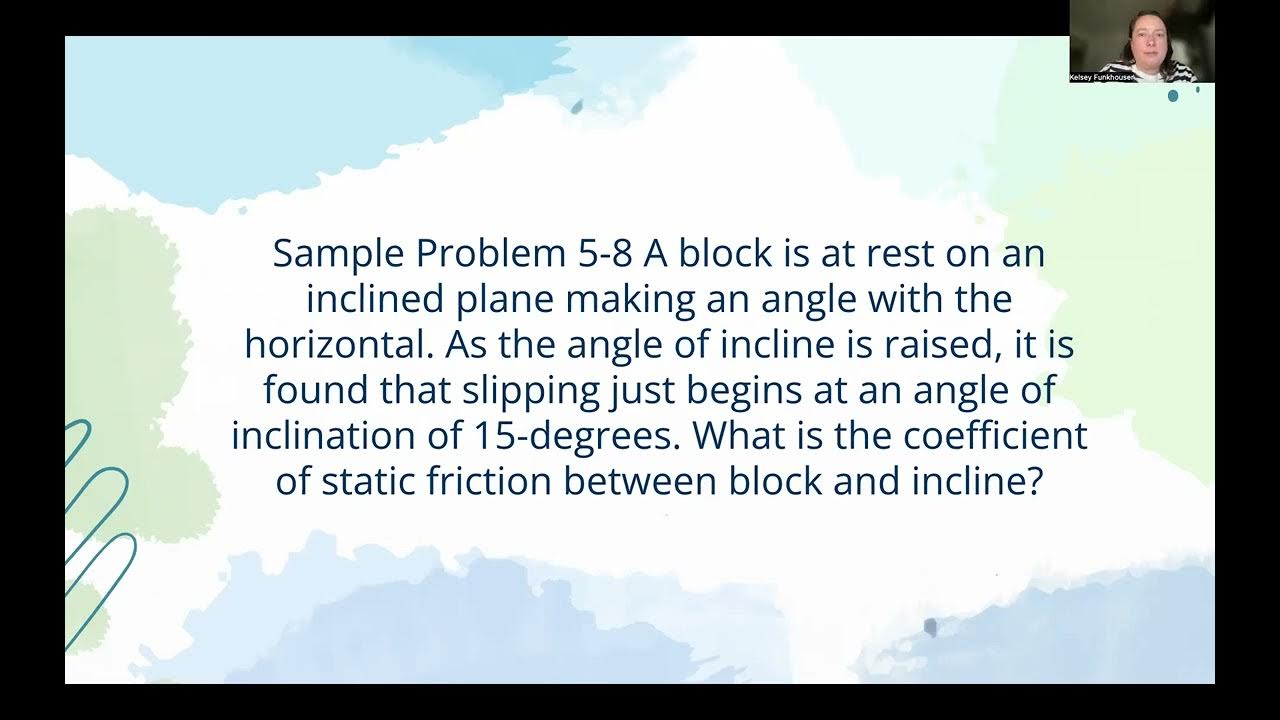Intuition on static and kinetic friction comparisons | Physics | Khan Academy
Summary
TLDRThis video explains why the coefficient of static friction is typically higher than that of kinetic friction. Through a combination of conceptual analogies and atomic-level insights, the speaker highlights how surfaces, when stationary, settle into imperfections, creating stronger resistance. In contrast, once motion begins, the surfaces do not have time to settle into these ruts, resulting in lower kinetic friction. The explanation delves into molecular interactions and electromagnetic forces, offering a deeper understanding of friction, while acknowledging that this phenomenon is still an area of ongoing research.
Takeaways
- 😀 Static friction is typically higher than kinetic friction, but why is that the case?
- 🧑🔬 At the atomic level, surfaces are never perfectly smooth, and this roughness affects frictional forces.
- 🔬 The difference between static and kinetic friction lies in how surfaces interact at the microscopic level.
- 💡 Static friction occurs when surfaces are stationary, allowing microscopic irregularities to lock together, requiring more force to overcome.
- 🚗 Kinetic friction happens when surfaces are in motion, and these microscopic irregularities no longer have the time to settle into place, resulting in less friction.
- 🧑🔬 When an object is moving, the surface molecules are constantly shifting, making it harder for the object to 'settle in' to the surface's grooves or ruts.
- 🔄 Static friction requires overcoming both molecular bonds and the mechanical interlocking of surface irregularities.
- 💥 Once an object starts moving, it doesn't have time to settle into these 'ruts,' so kinetic friction is lower.
- 🧑🔬 The force of friction comes from electromagnetic interactions between atoms, which prevent surfaces from truly touching.
- 🧠 The process of overcoming friction at the atomic level involves breaking and reforming molecular bonds, which occurs more frequently in kinetic friction.
- 🔍 The theory of friction is still an active area of research, and while some aspects are well-understood, others remain speculative or under investigation.
Q & A
Why is static friction usually greater than kinetic friction?
-Static friction is greater than kinetic friction because when an object is stationary, the microscopic irregularities on the surface allow the molecules to 'settle' into tiny ruts or grooves, requiring more force to break these bonds and initiate movement. Once the object starts moving, it doesn't have time to settle into these irregularities, leading to less frictional resistance.
What happens at the atomic level when static friction occurs?
-At the atomic level, the surfaces in contact aren't perfectly smooth. Molecules from both the object and the surface interact and can 'fit' into each other's microscopic irregularities, creating temporary bonds. To overcome static friction, these bonds must either be broken or the object must be shifted to move past these irregularities.
What is the role of molecular bonds in kinetic friction?
-In kinetic friction, while molecular bonds still form temporarily as the object moves, they break more easily because the object is constantly in motion. The bonds are not able to settle as firmly as in the static case, making it easier to keep the object moving compared to starting its motion.
How do surface irregularities affect friction?
-Surface irregularities create microscopic ruts or grooves that molecules from both the object and the surface can 'fit' into. These irregularities increase the force required to initiate movement (static friction), as the object must overcome these bond-like interactions before it can slide.
Why does static friction require more force than kinetic friction?
-Static friction requires more force because the object is not moving and thus the molecular interactions have time to settle into more stable configurations within the surface irregularities. This means more force is needed to overcome these 'locked' interactions and start the object moving.
What happens to friction once an object starts moving?
-Once an object starts moving, the surface irregularities no longer allow the molecules to 'settle' into place, and the bonds between the surfaces break more easily. As a result, the friction experienced while the object is moving (kinetic friction) is usually lower than when it is stationary (static friction).
How does the concept of free space in atomic structures relate to friction?
-Atoms are mostly made up of empty space, and when objects interact at the atomic level, it’s the repulsion between the electron clouds that causes resistance. Despite this vast amount of empty space, the forces between atoms—such as electromagnetic repulsion—lead to friction when objects are in contact.
What is the relationship between the coefficient of static and kinetic friction?
-The coefficient of static friction is generally higher than the coefficient of kinetic friction. This difference is due to the additional force needed to overcome the molecular interlockings when an object is stationary, compared to when it is already in motion.
Can friction be considered a purely physical phenomenon?
-No, friction involves both physical and chemical interactions at the atomic level. The temporary chemical bonds formed between the object and the surface, along with the physical interlocking of surface irregularities, play a key role in generating friction.
Is the explanation of static and kinetic friction universally accepted?
-While the general principles of static and kinetic friction are widely accepted, the exact mechanisms at the atomic level are still an area of ongoing research. Scientists continue to explore the detailed interactions that occur between surfaces during friction.
Outlines

このセクションは有料ユーザー限定です。 アクセスするには、アップグレードをお願いします。
今すぐアップグレードMindmap

このセクションは有料ユーザー限定です。 アクセスするには、アップグレードをお願いします。
今すぐアップグレードKeywords

このセクションは有料ユーザー限定です。 アクセスするには、アップグレードをお願いします。
今すぐアップグレードHighlights

このセクションは有料ユーザー限定です。 アクセスするには、アップグレードをお願いします。
今すぐアップグレードTranscripts

このセクションは有料ユーザー限定です。 アクセスするには、アップグレードをお願いします。
今すぐアップグレード関連動画をさらに表示

Friction 5 (Static and Kinetic)

PHYS 121 - Week 4 Lecture 2 - Friction & Circular Motion

Grade 11 Physics - Static and Kinetic Friction Example

Si el bloque está a punto de resbalar. ¿Cuál es el valor del coeficiente de rozamiento

Law Of Motion || Types Of Friction || Lecture No. 18

Fuerza de fricción o rozamiento
5.0 / 5 (0 votes)
